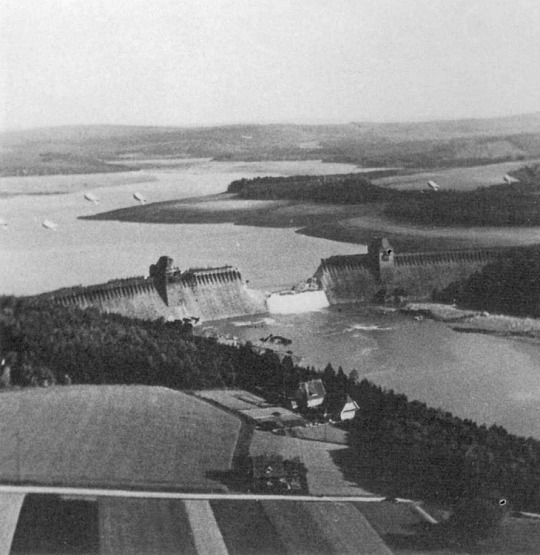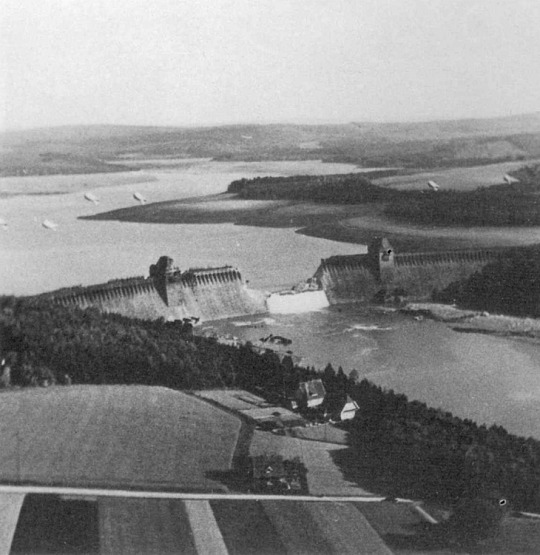#AirMinistry
Explore tagged Tumblr posts
Photo

Operation Chastise
Operation Chastise, the 'Dambusters' raid, was an attack by a squadron of RAF Lancaster bombers on the dams of the Ruhr basin in Germany in May 1943. Led by Squadron Leader Guy Gibson, the bombers breached two dams causing enormous flooding in the valleys below, disrupting industrial targets and killing at least 1,300 civilians.
Although the damaged factories, coal mines, and bridges were soon repaired, the mission showed the value of precision bombing by specially trained crews, diverted German resources to air defence, and reinvigorated Britain's position amongst its allies.
Objectives
The Ruhr basin in Western Germany was saturated with important heavy industry. These factories, many vital to the steel and armaments industry, were dependent on the water and hydroelectric power supplied by a series of massive dams. If Royal Air Force (RAF) bombers could breach the dams, the consequent floods would put the factories out of action. In a single mission, the same destructive result could be achieved that otherwise would have taken 3,000 bombers two weeks of bombing the factories directly. So vital was this area to the German war effort that RAF planners had considered it as a prime target before the war broke out in 1939. Operation Chastise was about to make these tentative plans a reality. Secondary aims of the operation were to deal a blow to German civilian morale and show both the British public and Britain's allies Russia and the United States that something was being done to take the war to Germany.
Five dams were targeted, but three were a priority: Möhne, Eder, and Sorpe. A second group, depending on the success against the first group, were Lister, Ennepe, and Diemel. The RAF knew that Möhne had air defences, and it was likely the others had, too. Möhne and Eder were concrete and, designed to withstand the massive pressure of water, immensely strong structures but relatively slim targets when seen from the air. Möhne, the primary target since a breach would directly flood the factories below (not the case with Eder), was the longest dam in Europe at 120 ft high (36.6 m), 25 ft thick (7.6 m) at the top, and 112 ft (34.1 m) thick at the base. The Möhne reservoir contained 140 million tons of water (Eder had 200 million). These dams were protected by two rows of anti-torpedo nets. Eder, much further to the east, was the second choice because it was concrete, although there were no military targets in the valley below. Sorpe was strategically more important than Eder, but because it was made of largely compacted earth, the effect of bombing was anticipated to be less. The destruction of these dams and others would require a completely new kind of bomb.
Continue reading...
21 notes
·
View notes
Text

Christian mission preaching to fans and locals at major sporting events and large community events


#street ministry#outreach program#outreach#open-airministry#ministry life#hockey games#great commission ministry#football games#festivals#fairs#CONCERTS#college outreach#college mission#college#Christian ministry#Christian College#chirstian missions#basketball games#baseball games
1 note
·
View note
Photo

Details of this beautiful ww2 British army Royal Air Force pilot bag. AM stands for Air Ministry. • • #GauthierBorsarello #Showroom #VintageForFashion #paris #inspiration #inspiring #research #fashion #fashiondesign #unique #rare #vintageclothing #vintage #menswear #mensstyle #mensfashion #design #selection #curation #ww2 #airministry #pilotbag #classic #kitbag #keepall #britisharmy #royalairforce (at Gauthier Borsarello Showroom)
#paris#unique#mensfashion#ww2#airministry#royalairforce#vintageclothing#inspiration#rare#menswear#kitbag#inspiring#vintage#design#vintageforfashion#selection#pilotbag#britisharmy#fashiondesign#curation#keepall#research#mensstyle#classic#fashion#gauthierborsarello#showroom
37 notes
·
View notes
Photo

Check out this great #WWII era British Air Ministry telephone directory!! Dated September 1943, this #worldwartwo artifact is available for $20 shipped in the United States. 📚✈️ #raf #britishairministry #airministry #royalairforce #1943 #wwiibritish #vintagetelephone #vintage #wartimeengland #ephemera #vintagebooks #retro #bookstagram #instabooks #igbooks #bibliophile #bookaneer #bookaneer4sale (at Dodge Center, Minnesota) https://www.instagram.com/p/BzV827FgHij/?igshid=15qvxd47zkpmf
#wwii#worldwartwo#raf#britishairministry#airministry#royalairforce#1943#wwiibritish#vintagetelephone#vintage#wartimeengland#ephemera#vintagebooks#retro#bookstagram#instabooks#igbooks#bibliophile#bookaneer#bookaneer4sale
0 notes
Photo

Nigella by Dhina A Air Ministry Pullin Pulnar 100mm f2.8 projector lens. https://flic.kr/p/2aA7iKN
0 notes
Photo

Just in store is this great WW2 piece , it's an sidcot suit liner that someone has turned into a jacket, the alterations were done in the 40's we believe #ww2 #raf #military #airministry #pilot #1940s #vintage #army
0 notes
Text
1940s Air Ministry Spitfire Aircraft Cockpit Lamp 5C/909
1940s Air Ministry Spitfire Aircraft Cockpit Lamp 5C/909 #spitfire #morsecode #communicationlamp #ww2 #airministry
1940s Air Ministry Spitfire Aircraft Cockpit Lamp 5C/909
This 1940s Air Ministry Spitfire Aircraft Cockpit Lamp 5C/909 has never been used. It is brand new, old stock, and comes with its original Air Ministry stock label attached. These lamps were used in WW2 as Morse Identity lights to ensure that the pilots could communicate with other aircraft without breaking radio silence. They were located…
View On WordPress
0 notes
Photo

WWII 1941 Air Ministry Wolsey Pilots Knit @somebodyandsons #airministry #wwii #raf
0 notes
Photo

Operation Chastise
Operation Chastise, the 'Dambusters' raid, was an attack by a squadron of RAF Lancaster bombers on the dams of the Ruhr basin in Germany in May 1943. Led by Squadron Leader Guy Gibson, the bombers breached two dams causing enormous flooding in the valleys below, disrupting industrial targets and killing at least 1,300 civilians.
Although the damaged factories, coal mines, and bridges were soon repaired, the mission showed the value of precision bombing by specially trained crews, diverted German resources to air defence, and reinvigorated Britain's position amongst its allies.
Objectives
The Ruhr basin in Western Germany was saturated with important heavy industry. These factories, many vital to the steel and armaments industry, were dependent on the water and hydroelectric power supplied by a series of massive dams. If Royal Air Force (RAF) bombers could breach the dams, the consequent floods would put the factories out of action. In a single mission, the same destructive result could be achieved that otherwise would have taken 3,000 bombers two weeks of bombing the factories directly. So vital was this area to the German war effort that RAF planners had considered it as a prime target before the war broke out in 1939. Operation Chastise was about to make these tentative plans a reality. Secondary aims of the operation were to deal a blow to German civilian morale and show both the British public and Britain's allies Russia and the United States that something was being done to take the war to Germany.
Five dams were targeted, but three were a priority: Möhne, Eder, and Sorpe. A second group, depending on the success against the first group, were Lister, Ennepe, and Diemel. The RAF knew that Möhne had air defences, and it was likely the others had, too. Möhne and Eder were concrete and, designed to withstand the massive pressure of water, immensely strong structures but relatively slim targets when seen from the air. Möhne, the primary target since a breach would directly flood the factories below (not the case with Eder), was the longest dam in Europe at 120 ft high (36.6 m), 25 ft thick (7.6 m) at the top, and 112 ft (34.1 m) thick at the base. The Möhne reservoir contained 140 million tons of water (Eder had 200 million). These dams were protected by two rows of anti-torpedo nets. Eder, much further to the east, was the second choice because it was concrete, although there were no military targets in the valley below. Sorpe was strategically more important than Eder, but because it was made of largely compacted earth, the effect of bombing was anticipated to be less. The destruction of these dams and others would require a completely new kind of bomb.
Continue reading...
32 notes
·
View notes
Photo

#Kittyhawks baking in the middleast desert sun #1942 #Airministry
0 notes
Photo

Operation Chastise
Operation Chastise, the 'Dambusters' raid, was an attack by a squadron of RAF Lancaster bombers on the dams of the Ruhr basin in Germany in May 1943. Led by Squadron Leader Guy Gibson, the bombers breached two dams causing enormous flooding in the valleys below, disrupting industrial targets and killing at least 1,300 civilians.
Although the damaged factories, coal mines, and bridges were soon repaired, the mission showed the value of precision bombing by specially trained crews, diverted German resources to air defence, and reinvigorated Britain's position amongst its allies.
Objectives
The Ruhr basin in Western Germany was saturated with important heavy industry. These factories, many vital to the steel and armaments industry, were dependent on the water and hydroelectric power supplied by a series of massive dams. If Royal Air Force (RAF) bombers could breach the dams, the consequent floods would put the factories out of action. In a single mission, the same destructive result could be achieved that otherwise would have taken 3,000 bombers two weeks of bombing the factories directly. So vital was this area to the German war effort that RAF planners had considered it as a prime target before the war broke out in 1939. Operation Chastise was about to make these tentative plans a reality. Secondary aims of the operation were to deal a blow to German civilian morale and show both the British public and Britain's allies Russia and the United States that something was being done to take the war to Germany.
Five dams were targeted, but three were a priority: Möhne, Eder, and Sorpe. A second group, depending on the success against the first group, were Lister, Ennepe, and Diemel. The RAF knew that Möhne had air defences, and it was likely the others had, too. Möhne and Eder were concrete and, designed to withstand the massive pressure of water, immensely strong structures but relatively slim targets when seen from the air. Möhne, the primary target since a breach would directly flood the factories below (not the case with Eder), was the longest dam in Europe at 120 ft high (36.6 m), 25 ft thick (7.6 m) at the top, and 112 ft (34.1 m) thick at the base. The Möhne reservoir contained 140 million tons of water (Eder had 200 million). These dams were protected by two rows of anti-torpedo nets. Eder, much further to the east, was the second choice because it was concrete, although there were no military targets in the valley below. Sorpe was strategically more important than Eder, but because it was made of largely compacted earth, the effect of bombing was anticipated to be less. The destruction of these dams and others would require a completely new kind of bomb.
Continue reading...
20 notes
·
View notes